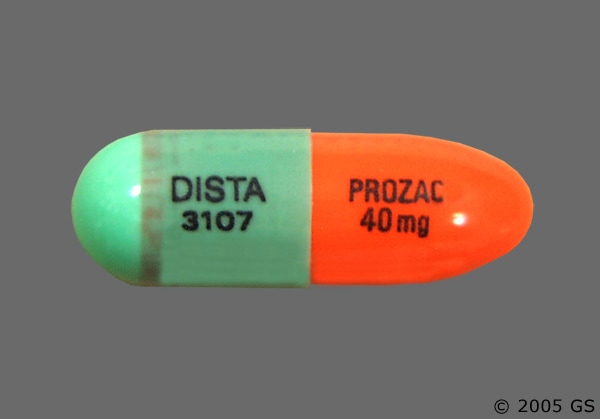Fluoxetine | Prozac
PROZAC® is a selective serotonin reuptake inhibitor indicated for:
- Acute and maintenance treatment of Major Depressive Disorder (MDD) in adult and pediatric patients aged 8 to 18 years (1.1)
- Acute and maintenance treatment of Obsessive Compulsive Disorder (OCD) in adult and pediatric patients aged 7 to 17 years (1.2)
- Acute and maintenance treatment of Bulimia Nervosa in adult patients (1.3)
- Acute treatment of Panic Disorder, with or without agoraphobia, in adult patients (1.4)
PROZAC and olanzapine in combination for:
- Acute treatment of Depressive Episodes Associated with Bipolar I Disorder in adults (1.5)
- Acute treatment of Treatment Resistant Depression in adults (Major Depressive Disorder in adult patients who do not respond to 2 separate trials of different antidepressants of adequate dose and duration in the current episode) (1.6)

—–INDICATIONS AND USAGE—–
- See description above.
—–DOSAGE AND ADMINISTRATION—–
- See description above.
—–CONTRAINDICATIONS—–
- Do not use with an MAOI or within 14 days of discontinuing an MAOI due to risk of drug interaction. At least 5 weeks should be allowed after stopping PROZAC before treatment with an MAOI (4, 7.1)
- Do not use with pimozide due to risk of drug interaction or QTc prolongation (4, 7.9)
- Do not use with thioridazine due to QTc interval prolongation or potential for elevated thioridazine plasma levels. Do not use thioridazine within 5 weeks of discontinuing PROZAC (4, 7.9)
- When using PROZAC and olanzapine in combination, also refer to the Contraindications section of the package insert for Symbyax (4)
—–WARNINGS & PRECAUTIONS—–
- Clinical Worsening and Suicide Risk: Monitor for clinical worsening and suicidal thinking and behavior (5.1)
- Serotonin Syndrome or Neuroleptic Malignant Syndrome (NMS)-like Reactions: Have been reported with PROZAC. Discontinue PROZAC and initiate supportive treatment (5.2)
- Allergic Reactions and Rash: Discontinue upon appearance of rash or allergic phenomena (5.3)
- Activation of Mania/Hypomania: Screen for Bipolar Disorder and monitor for mania/hypomania (5.4)
- Seizures: Use cautiously in patients with a history of seizures or with conditions that potentially lower the seizure threshold (5.5)
- Altered Appetite and Weight: Significant weight loss has occurred (5.6)
- Abnormal Bleeding: May increase the risk of bleeding. Use with NSAIDs, aspirin, warfarin, or drugs that affect coagulation may potentiate the risk of gastrointestinal or other bleeding (5.7)
- Hyponatremia: Has been reported with PROZAC in association with syndrome of inappropriate antidiuretic hormone (SIADH) (5.8)
- Anxiety and Insomnia: May occur (5.9)
- Potential for Cognitive and Motor Impairment: Has potential to impair judgment, thinking, and motor skills. Use caution when operating machinery (5.11)
- Long Half-Life: Changes in dose will not be fully reflected in plasma for several weeks (5.12)
- PROZAC and Olanzapine in Combination: When using PROZAC and olanzapine in combination, also refer to the Warnings and Precautions section of the package insert for Symbyax (5.14)
—–ADVERSE REACTIONS—–
- Most common adverse reactions (≥5% and at least twice that for placebo) associated with: Major Depressive Disorder, Obsessive Compulsive Disorder, Bulimia, and Panic Disorder: abnormal dreams, abnormal ejaculation, anorexia, anxiety, asthenia, diarrhea, dry mouth, dyspepsia, flu syndrome, impotence, insomnia, libido decreased, nausea, nervousness, pharyngitis, rash, sinusitis, somnolence, sweating, tremor, vasodilatation, and yawn (6.1) PROZAC and olanzapine in combination – Also refer to the Adverse Reactions section of the package insert for Symbyax (6)
—–DRUG INTERACTIONS—–
- Monoamine Oxidase Inhibitors (MAOI): PROZAC is contraindicated for use with MAOI’s, or within 14 days of discontinuing an MAOI due to risk of drug interaction. At least 5 weeks should be allowed after stopping PROZAC before starting treatment with an MAOI (4, 7.1)
- Pimozide: PROZAC is contraindicated for use with pimozide due to risk of drug interaction or QTc prolongation (4, 7.9)
- Thioridazine: PROZAC is contraindicated for use with thioridazine due to QTc interval prolongation or potential for elevated thioridazine plasma levels. Do not use thioridazine within 5 weeks of discontinuing PROZAC (4, 7.9)
- Drugs Metabolized by CYP2D6: Fluoxetine is a potent inhibitor of CYP2D6 enzyme pathway (7.9)

